Commemoration Operation Quick Anger 2025: On The 12th of April 1945, thousands of Allied military vehicles mustered nearby Westervoort to cross the IJssel towards Arnhem to liberate the city. The Allies had to cross the IJssel from the east, towards Arnhem on the western bank. The Allied plan to liberate Arnhem is known as Operation Quick Anger. The attack was preceded by heavy artillery shelling and mortar fire. From Westervoort, in two hours time, over 70,000 shells were fired against the German positions on the western side of the IJssel. In September 1944, after the lost Battle of Arnhem, the inhabitants of Arnhem and Westervoort were already evacuated. Immediately after the shelling, the Allies put up massive smoke screens and the first Allied troops crossed the IJssel in boats and amphibious vehicles, they secured a bridge head on the western bank. After heavy fighting at Fort Westervoort and the Enka Factory in the Kleefse Waard, the German troops surrendered. Within eleven hours after the beginning of Operation Quick Anger, the Allies had constructed a Bailey Bridge across the river IJssel, and thousands of Allied vehicles and soldiers crossed the bridge towards Arnhem. Within a few days, Arnhem was liberated and under Allied control. This Second Battle of Arnhem, in which Westervoort has played a crucial role, has never received as much publicity as the lost Battle of Arnhem, which was fought in and around Arnhem and Oosterbeek from 17 to 26 September 1944. Operation Quick Anger was conducted in conjunction with Operation Cannon Shot, a military operation to cross the IJssel at the villages of Gorssel and Wilp.
April 12, 2025, marks the 80th anniversary of Operation Quick Anger. On the 12th of April 2025, exactly 80 years since Operation Quick Anger took place, we participated in the commemoration of Operation Quick Anger. The Commemoration of Operation Quick Anger and a Memorial Tour is held annually since 2011. WWII vehicles and their owners gathered at Vredenburg House in Westervoort for the memorial tour. In our own WWII Ford Jeep, together with the other WWII vehicles and their owners, we drove through the Liemers, a rural region east of the IJssel. The tour ended at the Crossing to Liberation Monument on the bank of the IJssel in Westervoort, where we attended the memorial and wreath-laying ceremony, the war memorial is located at the very spot where the Western Allies crossed the IJssel on 12 April 1945 to liberate Arnhem. The memorial is located on the Liberation Route Europe, an international memorial trail that connects important places and memorial sites of the European history during World War Two.
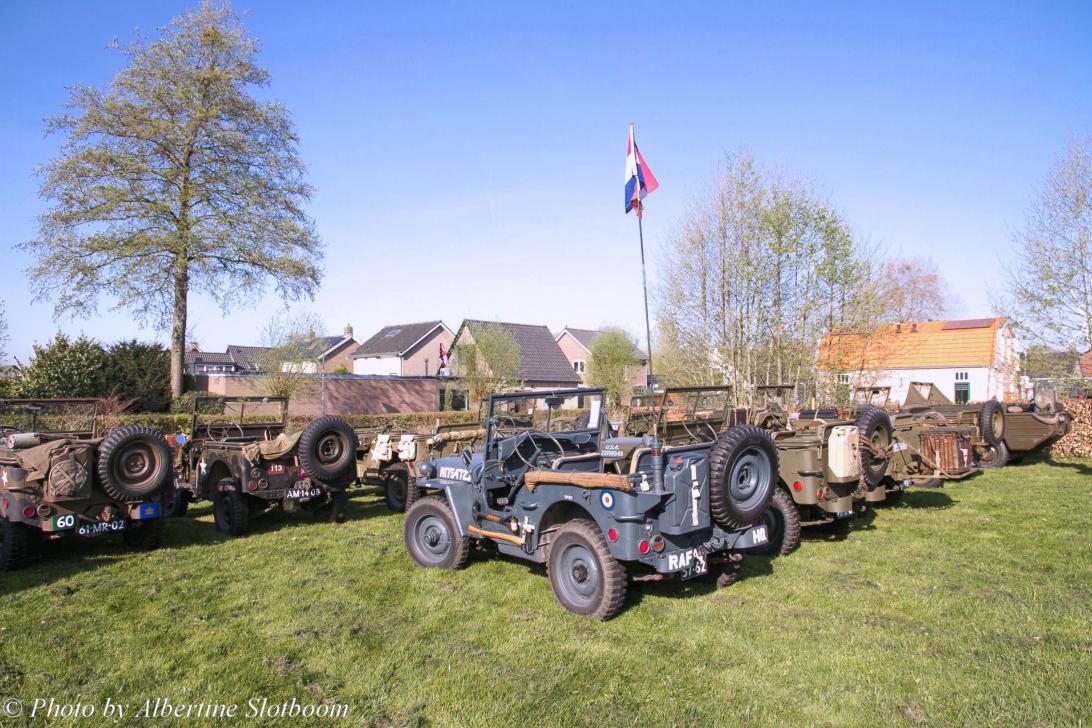
Westervoort, Commemoration Operation Quick Anger 2025: More than fifty authentic WWII vehicles and their owners gathered at Vredenburg House to participate in the commemoration of Operation Quick Anger, an Allied military operation that took place 80 years ago. The vehicles are ready for the Operation Quick Anger Memorial Tour 2025. On the 12th of April 2025, it was exactly 80 years since Operation Quick Anger took place.

Westervoort, Commemoration Operation Quick Anger 2025: More than fifty authentic WWII vehicles and their owners gathered at Vredenburg House to participate in the commemoration of Operation Quick Anger, an Allied military operation that took place 80 years ago. The vehicles are ready for the Operation Quick Anger Memorial Tour 2025. On the 12th of April 2025, it was exactly 80 years since Operation Quick Anger took place.
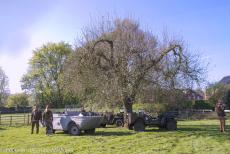
Westervoort, Commemoration Operation Quick Anger 2025: A 1943 Ford GPA in the grounds of Huize Vredenburg. A Ford GPA is the amphibious version of the WWII Ford GPW Jeep. The Ford GPA Jeep is also known as Seep or Swimming Jeep. The Ford Motor Company was commissioned to produce the Jeep GPA for the U.S. Navy in April 1942. The Ford GPA Jeep is incredibly rare and valuable, because very few have survived.
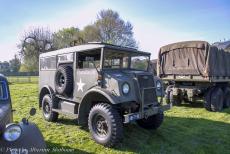
Commemoration Operation Quick Anger 2025: A 1944 Chevrolet C8A at Vredenburg House in Westervoort. The Chevrolet C8A was designed and built by General Motors of Canada. About 13,000 Chevrolet C8A vehicles were built in Canada, they were used by the British Army and Commonwealth armies. They were used for multiple purposes such as transport, evacuation, communication and also as command car.
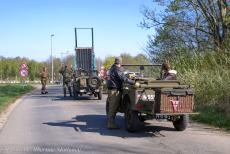
Commemoration Operation Quick Anger 2025: During the memorial tour, the convoy of more than fifty military vehicles of WWII stopped in front of an open drawbridge in Laag-Keppel. In the last days of WWII, all the bridges crossing the river Oude IJssel were destroyed by the Germans. The drawbridge, called Mulra, was rebuilt in 1951. The bridge is situated at 't Mulra, a beautiful nature reserve.
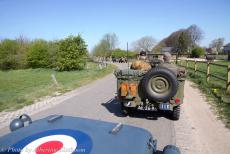
Commemoration Operation Quick Anger 2025: In April 1945, Operation Quick Anger was an Allied military operation to liberate the city of Arnhem. To commemorate this military operation, a memorial tour was held. The tour passed through the rural landscape of the Liemers and the rolling hills of Montferland, where in the beginning of April 1945 the Allied forces advanced from the east to liberate the Netherlands.
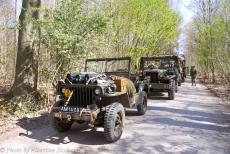
Commemoration Operation Quick Anger 2025: A WWII Ford GPW British Airborne Jeep, for instance recognisable by the cut down front bumper and the emblem of the British 1st Airborne Division painted on the bumpers and the windshield frame, the Pegasus Emblem is a light blue Pegaus on a maroon background. The 1st Airborne Division was formed in 1941. The British 6th Airborne Division was formed in 1944, they also used the Pegasus emblem. In Greek Mythology, Pegasus is an immortal winged horse.
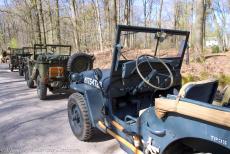
Commemoration Operation Quick Anger 2025: Our own Ford GPW Jeep was produced by the Ford Motor Company in april 1942. When the Allied forces invaded Normandy in June 1944 to liberate Nazi-Germany occupied Europe, they used vehicles, such as Jeeps. Our own Jeep was one of them. We use the Jeep for memorial tours, commemoration anf celebration ceremonies, the arrival of Sinterklaas and classic car tours. The Jeep is painted in Royal Air Force blue.
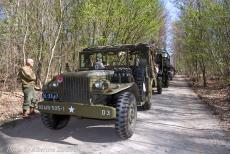
Commemoration Operation Quick Anger 2025: A 1942 Dodge WC 51. Throughout WWII, the Dodge Company was the sole producer of 3/4-ton trucks, Dodge built a total of 255,193 of these trucks, they were built as weapons carriers, WC is not an abbreviation for weapons carriers, but a standard manufacturing code of the Dodge Company, an iconic American brand, also known for its civilian cars. The Dodge Company was fouded in 1914.
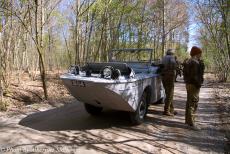
Commemoration Operation Quick Anger 2025: The amphibious Ford GPW Jeep, also known as Seep, Seagoing Jeep. Seeps served with the Allied forces in WWII, in the Pacific, the Eastern Front and the landings in Sicily and Normandy. The Seep was not a successful design, it was to heavy and slow on land and its seagoing abilities were insufficient, the Seep was also unable to handle the force of the waves.
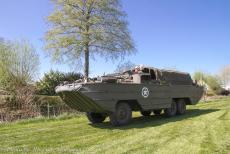
Commemoration Operation Quick Anger 2025: A 1944 GMC DUKW entering the grounds of Huize Vredenburg, Vredenburg House. The white star roundel was prominent on US vehicles in WWII and also in the Korean War. The DUKW became the main amphibious truck of the Allied Forces in WWII. Between 1942 and 1945, 21,147 DUKWs were built. DUKWS were used for the transportation of goods and troops over land and water. The DUKW was the most successful amphibious vehicle of WWII.

Commemoration Operation Quick Anger 2025: A British Airborne Jeep, a 1943 Willys Jeep, painted in the popular Mickey Mouse camouflage pattern. The British Airborne Jeep underwent numerous modifications to make it transportable in a Horsa Glider, for instance, the steering wheel was fitted with a quick release mechanism to enable it to be removed quickly to load the Jeep in a Horsa Glider, or folding the windshield down to save space.
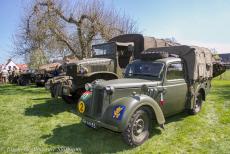
Commemoration Operation Quick Anger 2025: A 1939 Austin Ten Light Utility on display at the grounds of Vredenburg House in Westervoort. In 1939, a new model Austin was introduced, the Austin Ten Light Utility, this pick-up version was used by the army and was called fondly 'Tilly', Utility cars were used for communication, transport and evacuation of casualties. About 29,000 Austin Ten Light Utility cars were produced during WWII, but very few survive today.
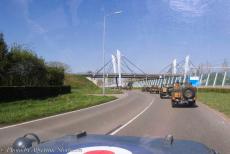
Commemoration Operation Quick Anger 2025: The convoy of WWII military vehicles passed the Ferguson Bridge in Zevenaar. In 2004, the bridge was named after Kenneth Scott Ferguson, the nineteen year old Canadian soldier was killed in action on the 2nd April 1945 near the former level crossing east of the bridge during the liberation of Zevenaar. One day later, Zevenaar was liberated.
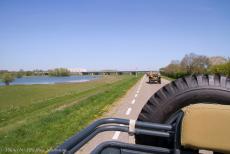
Commemoration Operation Quick 2025: The IJssel Bridge at Westervoort. Westervoort is located on the east bank of the IJssel and Arnhem on the opposite bank. At Westervoort, the IJssel splits from the Nederrijn, this point is called the IJsselkop, IJssel Head, a strategic location. The bridge was blown up by Dutch military engineers in 1940 to slow down the German advance in the Netherlands. At the end of WWII, the Germans destroyed the bridge to stop the Allied advance.
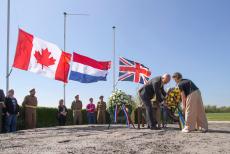
Commemoration Operation Quick Anger 2025: During the memorial ceremony of Operation Quick Anger at the Crossing to Liberation Monument in Westervoort, floral wreaths were laid by the King's Commissioner in the Province of Gelderland, the Mayor of Westervoort, the mayors of the surrounding villages, descendants of soldiers who were killed during Operation Quick Anger and primary school children.

Commemoration Operation Quick Anger 2025: Members of the Dutch Polar Bears laid a wreath and one of them recited the Act of Remembrance, the most famous stanza from the poem 'For the Fallen': They shall not grow old, as we that are left grow old: Age shall not weary them, nor the years condemn. At the going down of the sun, and in the morning, we will remember them. The moving poem 'For the Fallen' was written by the English poet Laurence Binyon in 1914, only a few weeks after the outbreak of the First World War.
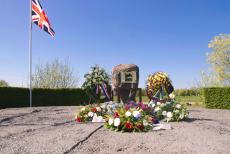
Commemoration Operation Quick Anger 2025: The Crossing to Liberation war monument commemorates the Allied soldiers who died here in April 1945 during Operation Quick Anger. The military Operation Quick Anger is sometimes called the Second Battle of Arnhem or the Forgotten Battle. The Second Battle of Arnhem was won, Arnhem was liberated. A month later the whole of the Netherlands was liberated.
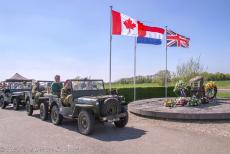
Commemoration Operation Quick Anger 2025 at the Crossing to Liberation Monument on the bank the IJssel in Westervoort: After the commemoration ceremony, the WWII vehicles slowly drove past the war monument as a tribute to the soldiers who fought for our freedom. In front of the convoy, a WWII Ford GPW British Airborne Jeep, as used during the Battle of Arnhem in September 1944.
